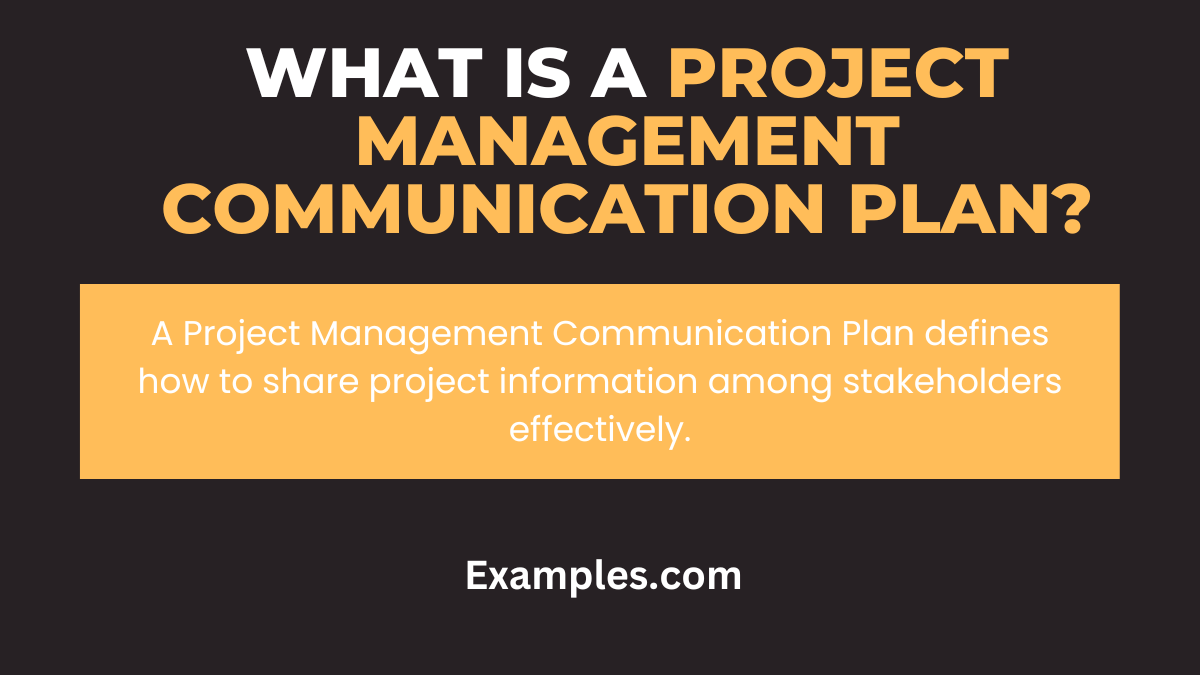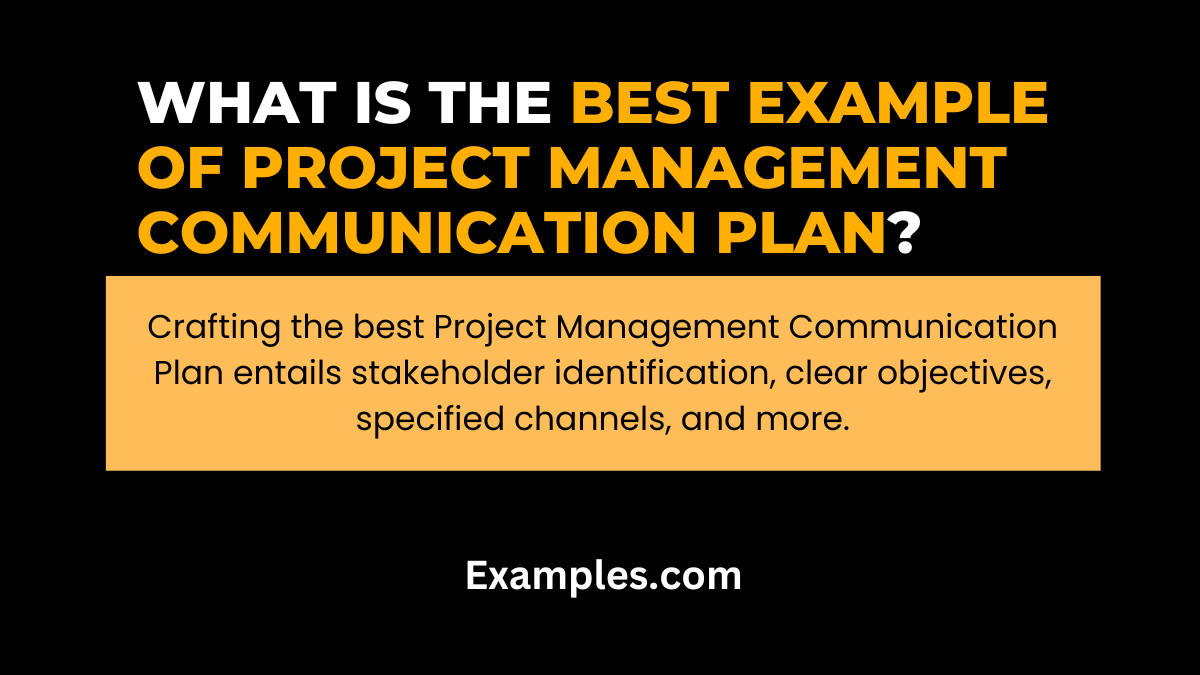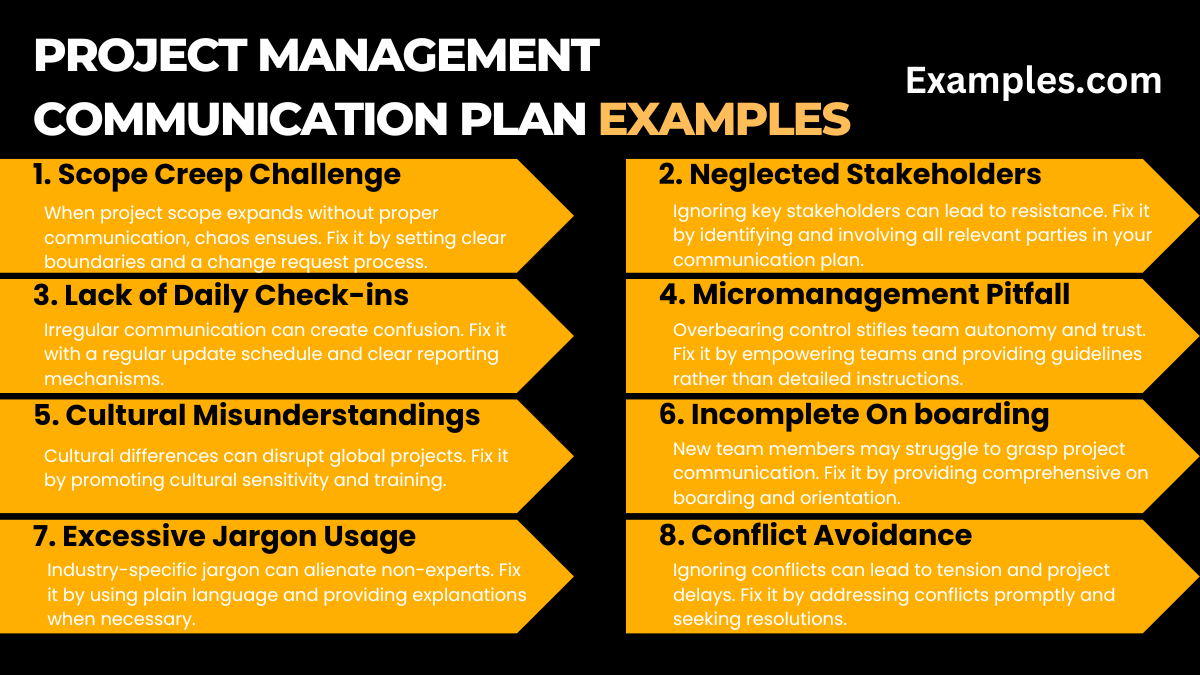9+ Project Management Communication Plan Examples
Welcome to the comprehensive guide on Project Management Communication Plans. In this in-depth resource, we’ll explore the intricacies of crafting and executing an effective Project Management Communication Plan. Backed by real-world Communication Examples, we’ll delve into its importance, components, and best practices. Whether you’re a seasoned project manager or just starting, this guide equips you with the knowledge and tools to enhance communication within your projects. Join us as we unlock the power of effective communication in project management.
Download List of Project Management Communication Plan
What is a Project Management Communication Plan?

A Project Management Communication Plan is a strategic blueprint that outlines how communication will be managed throughout the life cycle of a project. In simple English, it’s like a road map that guides the flow of information between everyone involved in a project, from team members to stakeholders.
This plan details what information will be communicated, how it will be delivered, who will receive it, and when it will be sent out. It ensures that everyone is on the same page and understands their roles, responsibilities, and the current status of the project. By setting clear communication guidelines, it helps in avoiding misunderstandings and keeps the project running smoothly. The plan is flexible and can be adjusted as the project evolves, but it serves as an essential foundation for effective communication in project management.
What is the Best Example of Project Management Communication Plan?

The best example of a Project Management Communication Plan is one that meticulously identifies all stakeholders, including team members, clients, and end-users. It defines clear communication objectives, such as regular updates, issue resolution, and transparency. The plan specifies communication channels, like emails, meetings, or project management software, along with their frequency. Content-wise, it covers project goals, milestones, risks, and scope changes. Roles and responsibilities are clearly assigned, and escalation procedures are in place for critical issues. Feedback mechanisms are encouraged, and comprehensive documentation ensures accountability. Regular reviews refine the plan’s effectiveness
10 Project Management Communication Plan Examples

Effective strategies for seamless project communication. Each example highlights common communication challenges and offers practical solutions. Discover how to enhance your communication plan and ensure successful project management.
- Scope Creep Challenge: When project scope expands without proper communication, chaos ensues. Fix it by setting clear boundaries and a change request process.
- Neglected Stakeholders: Ignoring key stakeholders can lead to resistance. Fix it by identifying and involving all relevant parties in your communication plan.
- Inconsistent Updates: Irregular communication can create confusion. Fix it with a regular update schedule and clear reporting mechanisms.
- Micromanagement Pitfall: Overbearing control stifles team autonomy and trust. Fix it by empowering teams and providing guidelines rather than detailed instructions.
- Cultural Misunderstandings: Cultural differences can disrupt global projects. Fix it by promoting cultural sensitivity and training.
- Incomplete On boarding: New team members may struggle to grasp project communication. Fix it by providing comprehensive on boarding and orientation.
- Excessive Jargon Usage: Industry-specific jargon can alienate non-experts. Fix it by using plain language and providing explanations when necessary.
- Failure to Adapt: Sticking to a rigid plan despite changing circumstances can lead to failure. Fix it by being flexible and adapting the communication plan as needed.
- Conflict Avoidance: Ignoring conflicts can lead to tension and project delays. Fix it by addressing conflicts promptly and seeking resolutions.
- Lack of Follow-Up: Failing to follow up on previous communications can lead to dropped tasks and misunderstandings. Fix it by establishing a system for tracking and following up on communication.
How to Create a Project Management Communication Plan?
Creating an effective Project Management Communication Plan is essential for the success of any project. Follow these steps to create a robust plan:
- Identify Stakeholders: Begin by identifying all project stakeholders, both internal and external. This includes team members, clients, end-users, and anyone who has an interest in the project’s outcome.
- Define Objectives: Clearly outline your communication objectives. What do you want to achieve with your communication plan? Is it to provide regular updates, address concerns, or ensure transparency?
- Choose Communication Channels: Select the communication channels that are most suitable for your project. Common channels include emails, meetings, project management software, and even social media communication.
- Determine Frequency: Establish how often communication will occur. Will you have daily stand-up meetings, weekly progress reports, or monthly updates? The frequency should align with the project’s needs.
- Craft Message Content: Define what information will be communicated. This should include project goals, milestones, potential risks, changes in scope or schedule, and any other relevant details.
- Assign Roles and Responsibilities: Clearly assign roles and responsibilities for communication tasks. Who will be responsible for sending updates, receiving feedback, and addressing issues?
- Set Escalation Procedures: Outline escalation procedures for critical issues. Determine when and how higher management or stakeholders should be involved when problems arise.
- Encourage Feedback: Create mechanisms for collecting feedback and suggestions from team members and stakeholders. Actively seeking and incorporating feedback can improve communication.
- Plan for Risk Communication: Develop strategies for communicating project risks, mitigation plans, and any potential impact on project timelines.
- Document Everything: Emphasize the importance of documenting all communication for future reference and auditing purposes. Maintain a central repository for easy access.
Building a Project Management Communication Plan
Building a Project Management Communication Plan is a structured and strategic process that involves the following key steps:
- Project Analysis: Begin by thoroughly analyzing the project’s objectives, scope, stakeholders, and communication requirements. Understanding the project’s specific context is crucial for building an effective communication plan.
- Identify Stakeholders: Identify and list all project stakeholders, both internal and external. This includes team members, clients, sponsors, regulatory bodies, and any other individuals or groups with a vested interest in the project’s success or outcome.
- Stakeholder Assessment: Assess the communication needs and preferences of each stakeholder group. Consider factors such as their level of involvement, communication style, and the type of information they require.
- Define Communication Objectives: Clearly define the objectives of your communication plan. What are you aiming to achieve through communication? Your objectives should align with the project’s goals and the expectations of your stakeholders.
- Select Communication Channels: Choose the most appropriate communication channels for reaching each stakeholder group. Consider the nature of the information, the urgency of communication, and the preferences of your audience. Common communication channels include emails, meetings, reports, newsletters, and project management software.
- Craft Message Templates: Develop message templates and guidelines for various types of communication. These templates can include standard formats for progress reports, meeting agendas, and issue resolution. Consistent messaging ensures clarity and reduces the risk of misunderstandings.
- Assign Roles and Responsibilities: Clearly define the roles and responsibilities of team members involved in communication. Designate individuals responsible for sending updates, responding to stakeholder inquiries, and managing communication tools and platforms.
- Set Communication Frequency: Establish a communication schedule that outlines when and how often communication will occur. This can include regular team meetings, status updates, milestone reports, and ad-hoc communication for urgent matters.
- Feedback Mechanism: Implement a feedback mechanism that allows stakeholders to provide input, ask questions, and share concerns. Encourage open and transparent communication to foster collaboration and problem-solving.
- Monitor and Adjust: Continuously monitor the effectiveness of your communication plan. Collect feedback from stakeholders and evaluate whether communication objectives are being met. Be prepared to make adjustments and refinements as necessary to improve communication processes.
What are the five 5 Components of a Project Communication Plan?
- Stakeholder Identification: The first component involves identifying all project stakeholders. This includes team members, clients, end-users, and anyone with a vested interest in the project’s outcome. Accurately identifying stakeholders is essential for effective communication.
- Communication Objectives: Clearly define the communication objectives of the plan. What do you aim to achieve through communication? It could be regular updates, issue resolution, transparency, or stakeholder engagement. Defining objectives provides direction.
- Communication Channels: Determine the communication channels to be used. Common channels include emails, meetings, project management software, reports, and even social media. Choosing the right channels ensures that messages reach the intended audience effectively.
- Message Content: Specify the content of the messages to be communicated. This should encompass project goals, milestones, potential risks, changes in scope or schedule, and other pertinent information. Well-crafted messages ensure clarity.
- Roles and Responsibilities: Assign roles and responsibilities for communication tasks within the project team. Clearly define who is responsible for sending updates, receiving feedback, addressing issues, and ensuring the smooth flow of communication.
Why is a Project Management Communication Plan Important?
- Clarity: It ensures that all project stakeholders have a clear understanding of project goals, progress, and expectations, reducing misunderstandings and confusion.
- Alignment: It aligns team members and stakeholders with the project’s objectives, fostering a shared sense of purpose and direction, which can enhance project commitment and motivation.
- Transparency: It promotes transparency by making project information readily available, reducing ambiguity, and preventing rumors or speculations that can negatively affect morale.
- Issue Resolution: It provides a structured approach to address project issues, helping to prevent minor problems from escalating into major obstacles that could jeopardize project success.
- Stakeholder Engagement: It engages and involves all relevant stakeholders, ensuring that their concerns are heard and addressed. Engaged stakeholders are more likely to support the project.
- Risk Mitigation: It helps identify and communicate project risks and mitigation strategies, enabling proactive risk management and reducing the likelihood of unexpected setbacks.
- Accountability: It assigns responsibilities for communication tasks, ensuring that everyone knows their role in the communication process, which minimizes confusion and delays.
- Continuous Improvement: It encourages feedback and allows for the improvement of communication strategies over time, enhancing overall project efficiency and effectiveness.
A well-structured Project Management Communication Plan is an indispensable tool for project managers. It ensures that information flows smoothly, stakeholders are engaged, and the project remains on course, ultimately contributing to project success.
What is a Stakeholder Communication Plan in Project Management?
A Stakeholder Communication Plan outlines how project information will be shared with stakeholders to ensure their engagement, alignment, and satisfaction throughout the project.
What is Communication in Software Project Management?
Communication in software project management involves exchanging information, updates, and feedback among project stakeholders to facilitate collaboration, transparency, and successful project delivery.
How to use a Communication Plan for Project Management?
To use a communication plan effectively, define objectives, choose suitable channels, assign roles, encourage feedback, and adapt as needed. Regularly review and document communication for project success.
The effectiveness of a Project Management Communication Plan hinges on its comprehensive nature and adaptability. It should meticulously identify all stakeholders and define clear objectives, such as regular updates, issue resolution, and transparency. Utilizing various channels like emails, meetings, and project management software, while ensuring regularity and clarity in communication, is essential. Additionally, addressing common challenges like scope creep, stakeholder neglect, and inconsistent updates enhances the plan’s effectiveness. Regular reviews and feedback mechanisms are crucial for continuous improvement.
For further insights into building a robust Project Management Communication Plan, the Southern New Hampshire University offers a detailed discussion on the subject. Their article provides valuable perspectives on crafting a plan that resonates with the project’s requirements and stakeholder expectations. Visit Southern New Hampshire University – Communication Plan in Project Management.
Moreover, Wrike’s blog presents an engaging overview of what constitutes a successful project communication plan. This resource is particularly useful for understanding the practical aspects of communication in project management, offering real-world examples and strategies. Explore Wrike – What is a Project Communication Plan? for more information.



